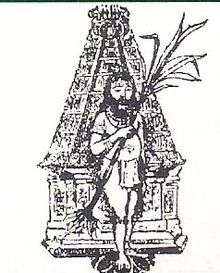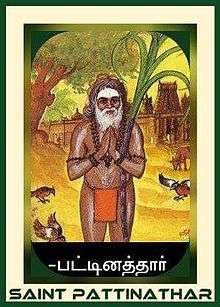Pattinathar
Saint Paṭṭiṉattār Tamil: பட்டினத்தார் was a Saivaite and a Spiritual leader.[1] He was born to Sivanesa and Gnanakalai. His father was a trader in Pumbuhar, Thanjavur district. His birth name was Swethaaranyar after an epithet of Lord Siva of Swethaaranyeswarar Temple. He was also called as Thiruvengadar by the people. When he was five years old, he lost his father. Like his father he spent money on Lord Shiva's devotees, and fed them daily. He was a trader and had enough wealth. At sixteen years, he was married to Sivakalai, daughter of another trader by the name of Sivasithamparam Chettiyar and his wife Sivakaamy. Even after fifteen years of marriage they had no children. Meantime there was a very poor Saivaite by the name of Sivasarumar who spent all his wealth in feeding the Lord Shiva's devotees. When all his wealth was spent he sold his wife's nuptial chain (Thaali) and fed the devotees of Lord Shiva. Once in his dream, Lord Shiva appeared and told him, he would find him (Shiva) as a baby at a certain spot. "Hand over the baby boy to Thiruvengadar. He would give you gold equal to the weight of the baby. The Saivaite devotees found the baby and took him to Pattinatthar. He adopted the child and gave the couple, gold and more wealth."[2]

Search for divinity
The divine child grew up and followed in his father's footsteps. Once the father sent him on a ship with a good lot of merchandise and when he came he just brought back sacks full of paddy husks. The father was angry and locked him up in a room and after going to the harbor, threw the husks out. He was surprised to see they were all gold; every dried piece of the husk turned out to be gold dust and also had precious gems in the sack. He hurried home to see his son. He was not in the locked room. His wife gave him a small box the son had given before he disappeared. In it was a palm-leaf manuscript and a needle without an eyelet. On the script were the following words (in English for understanding):
"Not even an eyeless needle will accompany you in the final journey of life."
Pattinathar (Thiruvengadar) realized the philosophy and wisdom of the words, and renounced everything - his wife, his wealth, his kith and kin and all other mundane attachments. With only a loin cloth he left.[3] He sang many philosophical songs to enlighten people on the blissful state of renunciation.[4] He sang about the human life and its complex dimensions, made his lyrics more appealing to the common man.[5] He urged repeatedly not to be attached to the body and its pleasures, for the body perishes and becomes food for animals and worms. Think of God and surrender at God's feet.[6]
Pattinatthar worshiped Shiva at the Srikalahasti temple, which has inspired great poetic and musical works.[7] The samadhi [attained salvation in this place] of Pattinatthar is a historic landmark located on the Ennore Expressway in Tiruvottiyur.[8] It is believed to be around 500 years[9] to 1100 years old .[10]
Inside the Nandrudayaan Vinayagar temple in Devadhanam, Tiruchirappalli, an idol for Pattinatthar is found.[11]
Folklore of Bharthari and Pattinathar

Bharthari was the elder son of King Gandharva-Sena, and received the kingdom of Ujjain from the celestial god Indra and the King of Dhara.[12][13]
When Bharthari was king of 'Ujjayani' (modern day Ujjain) in his state there lived a Brahman who after years of austerities was given the fruit of immortality from the celestial tree of Kalpavriksha. The Brahman presented the same to his monarch, Raja Bharthari, who in turn, passed it on to his love, the beautiful, Pinglah Rani or Ananga Sena (as per Maha Kavi Kalidas), Raja Bhartrhari's last and youngest wife. The queen, being in love with the Head police officer of the state, Mahipaala, presented the fruit to him, who further passed it on to his beloved, Lakha, one of the maids of honour. Eventually, Lakha being in love with the king presented the fruit back to the king. Having completed the circle, the fruit revealed the downsides of infidelity to the king, he summoned the queen and ordered her beheading, and ate the fruit himself. After that he abdicated the throne, to his younger brother Vikramaditya, and became a religious mendicant.[12][14]
He later became a disciple of Pattinatthar (Swetharanyar is poorvashram name of this saint from Poompuhar,Tamil Nadu) who first indulged in an argument about samsari and sanyasi with king Bhartrhari. Later during the conversation pattinathar said that all women have 'dual mind' and it might be the true case even with Parameswari. King conveyed this news to rani Pingalah and she ordered Pattinathar to get punished and to sit in 'kalu maram' (Tree, whose top portion would be sharpened like a pencil and whole tree is fully coated with oil, a person who is punished to sit in the top will be split into 2 pieces), they tried to kill pattinathar, but kalu maram started burning and nothing happened to Pattinathar, the king came to know this news and went directly to Pattinathar and asked him to get ready to die the next day, but Pattinathar replied, " I'm ready right now, to die". The next day king came with tears in his eyes and released saint from jail because he actually noticed queen pingalah in love with horsemen that night, He threw away his empire, wealth, even full coat dress and dressed in a simple kovanam (loin cloth), the king became a disciple of Pattinatthar and got mukthi (salvation) in Kalahasthi temple.
In Popular culture
In 1935, Saint Pattinathar film was released, starring C. S. Sundaramurthy Odhuvaar in the title role. In 1962, a later day version came out with T. M. Soundararajan as the Saint Pattinatthar.[15]
References
- ↑ "Practical approach to spiritual life". The Hindu. India. 11 October 2000.
- ↑ "Teachings of Impermanence". Daily News. Sri Lanka. 30 October 2009. Archived from the original on 18 October 2011.
- ↑ "Power of detachment". The Hindu. India. 14 May 2009.
- ↑ "Trials undergone by Pattinathar". The Hindu. India. 26 December 2002.
- ↑ "Tradition vs modernity dilemma in Tamil literature". The Hindu. Coimbatore, India. 25 June 2010.
- ↑ "The Perishable body". The Hindu. Chennai, India. 7 June 2010.
- ↑ "The tale of Kalahasti". The Hindu. India. 4 June 2010.
- ↑ "Immaculate inside, filthy outside". The Hindu. Chennai, India. 28 May 2007.
- ↑ "Pattinathar temple". Dinamalar. India. Retrieved 31 January 2012.
- ↑ "Pattinathar temple kumbmela in Daily thanthi 22/1/2015.Title". .
- ↑ "Vinayaka in unique form". The Hindu. India. 10 October 2003.
- 1 2 Introduction Vikram and The Vampire by Richard Francis Burton, 1870.
- ↑ Footnote 13 Vikram and The Vampire by Richard Francis Burton, 1870.
- ↑ The Sikh Religion, Volume 1 Max Arthur Macauliffe [1842-1913], Oxford University Press [1909]. Chapter XIV.
- ↑ "Pattinathaar 1936". The Hindu. India. 17 October 2008.